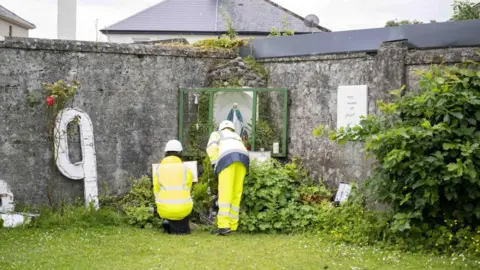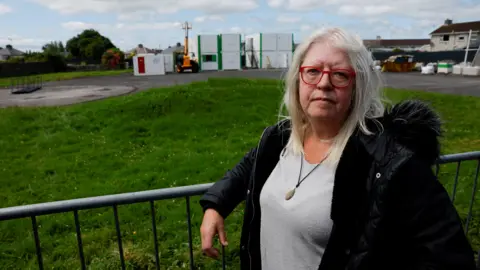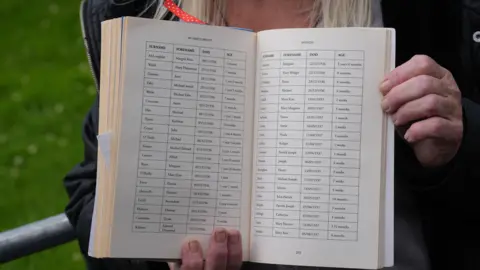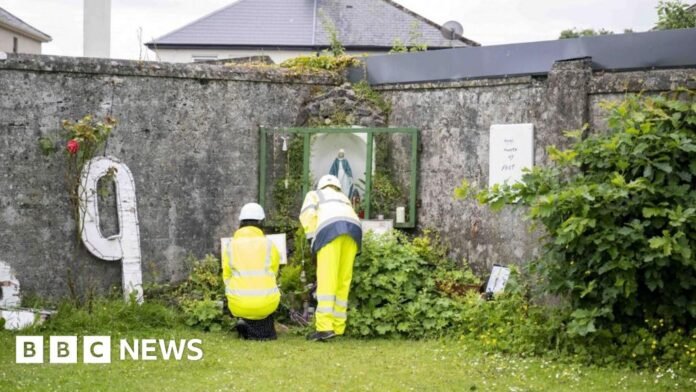BBC News Ireland correspondent
 PA Media
PA MediaThe full excavation of a mass grave of babies and young children at Tuam in County Galway is due to begin later on Monday.
The exhumations will be carried out at the site of an institution for unmarried mothers, which operated between 1925 and 1961.
The story came to international attention 11 years ago, after amateur historian Catherine Corless discovered there were death certificates for 796 babies and children who were in the institution, but no burial records.
In 2017, investigators found what they described as “significant quantities of human remains” at the site.
The bodies were in underground chambers in a disused sewage system.
The institution, which was known as St Mary’s mother-and-baby home, was run by Catholic religious order the Bon Secours Sisters and owned by Galway County Council.
Experts from Colombia, Spain, the UK, Canada, Australia and the United States have joined Irish specialists to take part in the unprecedented excavation process.
 Reuters
ReutersThe agency carrying out the operation is the Office of the Director of Authorised Intervention, Tuam (ODAIT), which took control of the site four weeks ago to begin preparatory work.
It is led by Daniel MacSweeney, who has described the excavation as “unique and incredibly complex”.
Scientists say the remains are largely “commingled” – in other words, the bones are mixed up.
A number of methods will be used to try to put remains back together and, where possible, identify them.
It is thought the excavation will go on until 2027, with follow-up work continuing for another three years.
About 80 people have so far come forward to give DNA samples, in the hope the bodies of their relatives may be recovered.
Anna Corrigan, who had two brothers who were born in the institution, said if they were found she would inter them with her mother Bridget Dolan.
“It’ll be closure, because I can put on her headstone – ‘pre-deceased by her sons John and William,” she said.
“I can’t do that at the moment, because I can’t be sure if they’re dead or not.”
An entry in the institution’s “discharges” ledger says William Joseph Dolan died in 1951.
But there is no death certificate for him.
 PA Media
PA MediaIn 2013, Anna reported him to An Garda Síochána (the Irish police service) as a missing person.
The following year, she also asked police to investigate what happened to John Desmond Dolan.
A certificate from 1947 registers the causes of his death as “measles” and “congenital idiot”.
“I contended that he died of neglect and malnutrition,” she said.
“After my mother left the home, she sent the nuns five shillings a month for his upkeep.
“So how did it come to this?”
Solicitors KRW Law have pursued the matters on her behalf, but so far there has not been an outcome.
She is “glad” the excavation is going ahead – but she is also nervous.
“There’s a possibility that in 2027, fifteen years on, I could still be back where I started,” she said.
“With still no indication that my brothers are actually dead – or they could be walking around somewhere in some country, having been illegally adopted.”
She is also campaigning for the Irish government to use the legislation which allows the Tuam exhumation to authorise other excavations in Ireland.
Her aunt, Mary “Mollie” Corrigan, was 13 when she died in an industrial school in Loughrea in County Galway, and there is no record of where she is buried.
Hoardings have been placed around the Tuam site, and 24-hour security will be in place while the excavation is carried out, with the area preserved to the same forensic standard as a police investigation.
The Bon Secours Sisters and Galway County Council have previously apologised.
The religious order has made a contribution of £2.14m towards the cost of the excavation.





